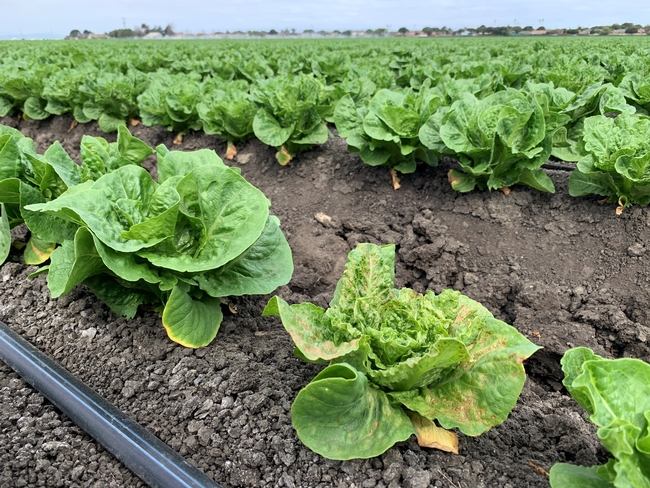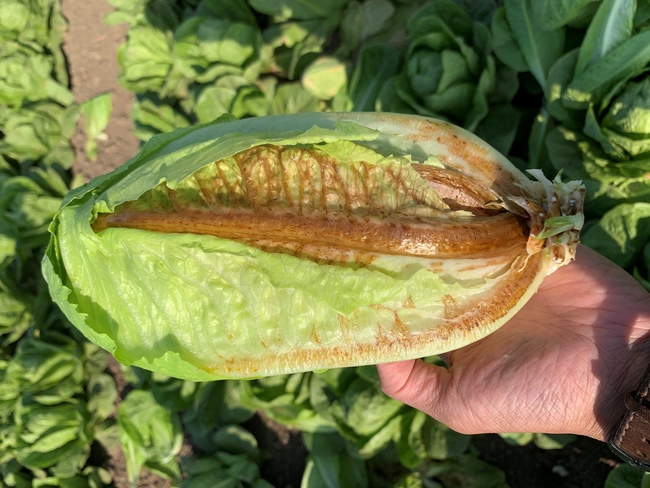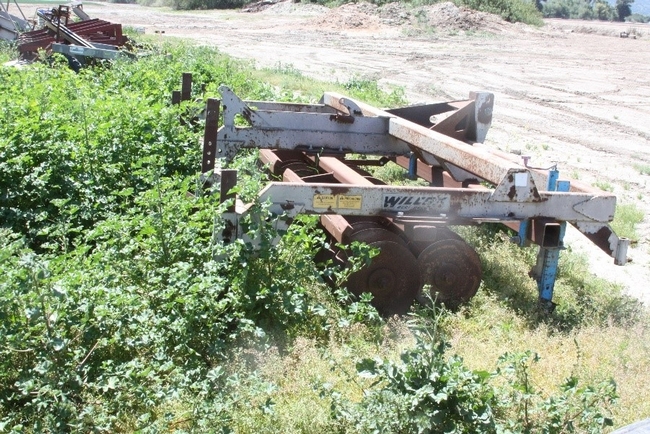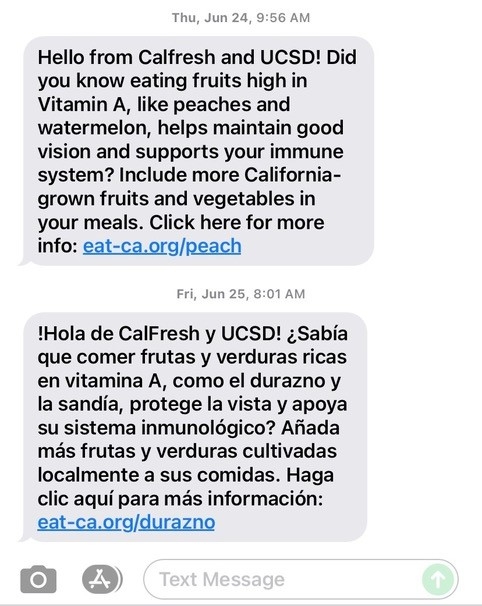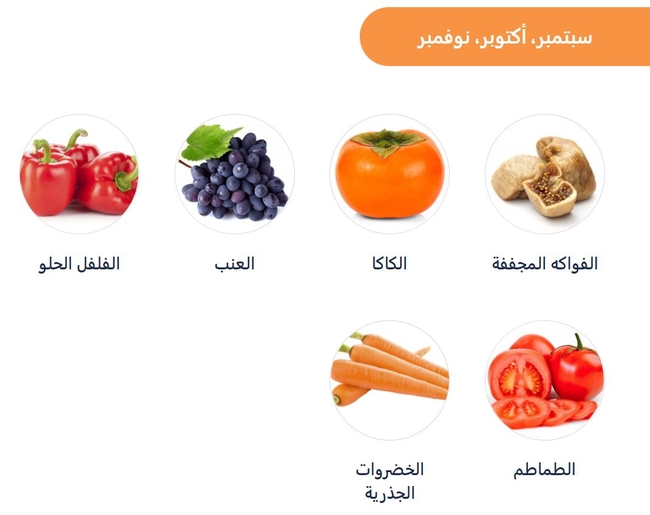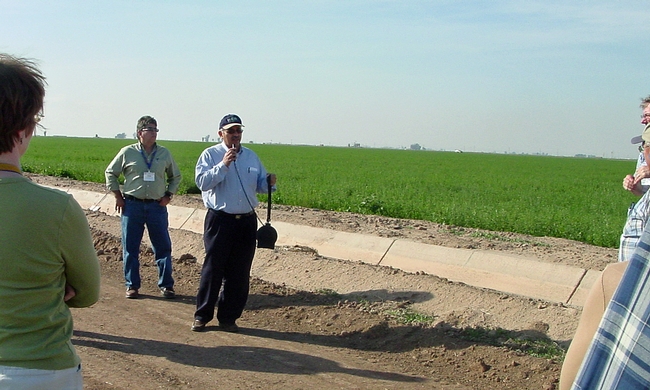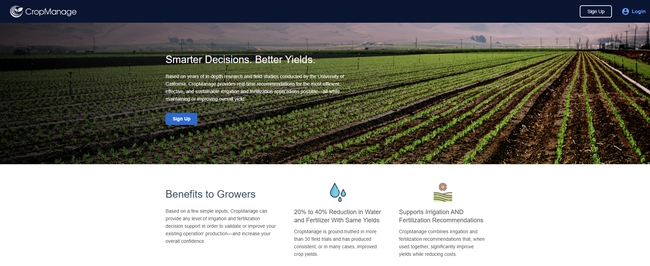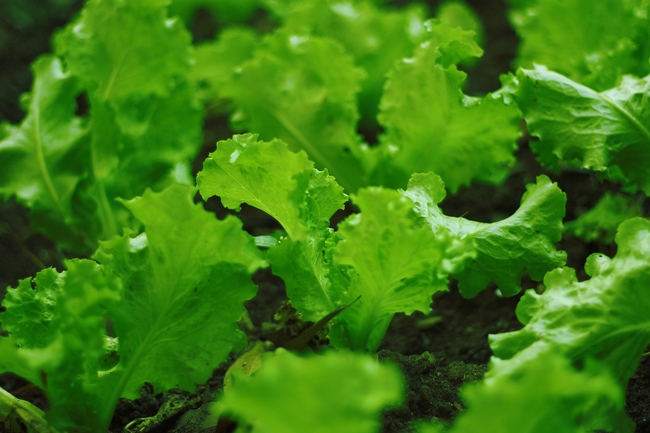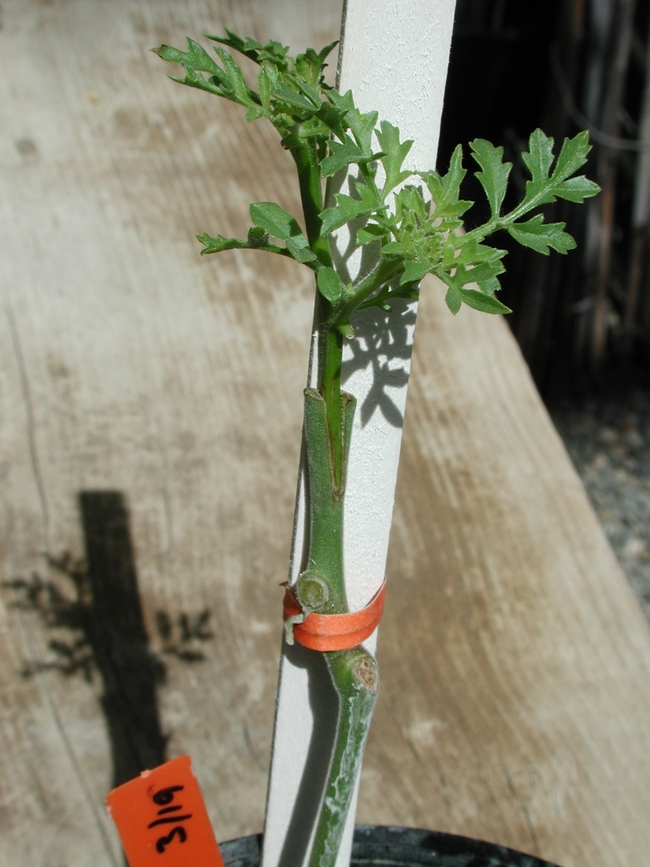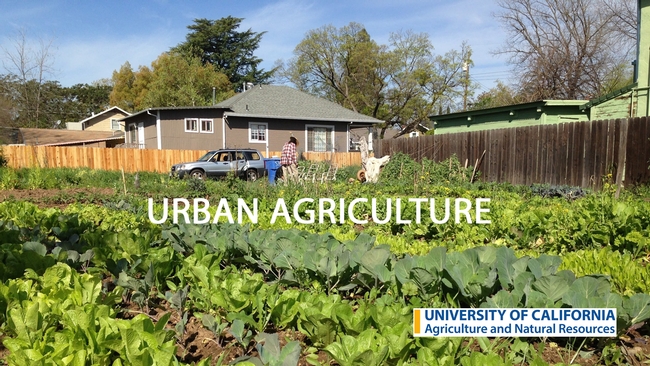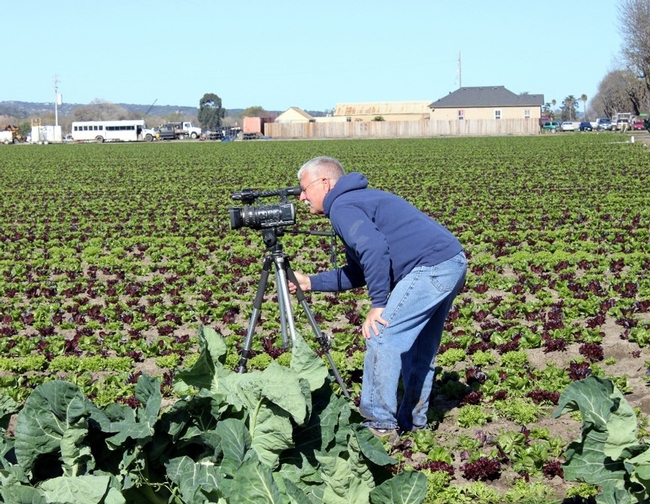Posts Tagged: vegetables
Lettuce growers hope weeding, research can counter devastating plant virus
Population explosion of insect vector contributed to $100 million in losses in 2020
While most Californians are wholeheartedly embracing the wet start to winter, one group is welcoming the rain more warily (and wearily) – lettuce growers in the Salinas Valley.
“It's a blessing, yes, we need the water,” said Tony Alameda, managing partner of Topflavor Farms, which grows a variety of produce in Monterey and San Benito counties. “But, oh gosh: with that water, here come the weeds, here comes the habitat, here comes all the other problems that go along with it.”
Weeds are overwintering havens for a tiny insect called the Western flower thrips, which in turn carries the impatiens necrotic spot virus (INSV) – a plant virus that caused $100 million in lost gross revenue for Salinas Valley growers in 2020.
The agricultural community called it “the biggest problem we've seen in a long, long time,” said Mary Zischke, facilitator of a task force convened by the Grower-Shipper Association to address INSV and a related affliction, Pythium wilt.
Widespread crop failure in 2020
Since INSV was first observed in the state in 2006, the virus – which poses no threat to people – triggered significant crop losses in 2019, leading up to a catastrophic 2020. As Alameda's lettuces began to show the telltale “bronzing” of the leaves, efforts to bag up or remove the infected plants had no effect on the virus' implacable spread.
“Nothing seemed to work,” he recalled, “and you just watch those fields collapse, week after week, until you're just like, ‘Ugh, there's nothing here to even harvest.'”
After “100% crop failure” that year in his prime fields at the heart of the Salinas Valley, Alameda tried to dodge the virus in 2021 – shifting lettuce plantings to San Benito County and instead using his most valuable land for unaffected crops such as cilantro, leeks and radishes. By decamping to San Benito, Alameda was able to harvest 70% of his usual lettuce yield.
Generally, growers enjoyed a reprieve from virus pressures in 2021. Even in this “good” year, however, about one-third of all lettuce plantings in the Salinas Valley had at least a low level of infection, according to Zischke.
“Since we were attributing a lot of our so-called good fortune – on having less damage this year – to the cooler weather, we know we can't count on that to get us out of this problem,” Zischke said. “All the models point to the fact that we're in a warming climate, so we were fortunate this year.”
More research needed on thrips
Heat waves were a major driver of the INSV disaster of 2020. Although researchers have established a link between warmer temperatures and population increases of thrips, science still has a lot to learn about those disease vectors.
“Thrips are something we're trying to understand as much as we can, but it's pretty tough because they're a little mysterious in the way they get around and where they overwinter,” said Richard Smith, a University of California Cooperative Extension vegetable crops and weed science farm advisor for the Central Coast region.
Smith – along with U.S. Department of Agriculture research entomologist Daniel Hasegawa and California State University-Monterey Bay plant pathologist JP Dundore-Arias – provided an INSV update during an Assembly agriculture committee hearing in December.
Recent studies have identified several weeds as key “reservoirs” of thrips, including malva, marestail, and hairy fleabane. The ubiquitous mustards, fortunately, appear to be poor hosts for thrips, although their pollen serve as potential food sources.
Controlling those weeds – which are beginning to spring up as the days lengthen – is a top priority during the winter months, according to Smith. Aggressive weed management in the preceding winter was an important factor in limiting the virus' spread in 2021.
And because weeds recognize no boundaries, experts are also urging managers of non-agricultural lands to keep their properties as clean as possible, including industrial sites, equipment yards and the edges of roadways – namely U.S. Route 101, which runs through the center of the valley. Some growers have been volunteering to weed their neighbors' vineyards.
“We're encouraging everybody – as best they can – to knock down known weed hosts; that's really critical,” Zischke said.
Search for long-term solutions
Within the grower community, there is “nervous optimism” for the coming year, said Alameda, as he continues to hope for an innovation that would aid in the fight against INSV – whether a more targeted pesticide application or a beneficial insect that could deter the thrips.
However, both Alameda and Zischke pointed to the breeding of more resistant lettuce varieties as the ultimate solution to INSV – albeit one that is years away.
“We have a lot of different types of lettuce that we grow, so to move resistance into all the different types of lettuce we grow throughout the season … that's going to take time,” Zischke explained.
Research funding from the state and USDA – as well as projects supported by the California Leafy Greens Research Program – can help expedite that process. But, for Alameda, the INSV crisis underscores the need for more resources and farm advisors such as Smith, who has spent more than three decades cultivating relationships and building trust within Salinas Valley communities.
Alameda would like to see a renewed focus on bringing “bright, young, passionate people who live and breathe this stuff” to the region, so growers are better equipped to handle the inevitable next calamity.
“Hopefully this is a wakeup call to all,” he said. “This is a valued industry – you have to take care of it; it cannot be taken for granted. The ‘salad bowl of the world' cannot rest on its laurels.”
CalFresh participants welcome texts on benefits of California-grown produce
The buzz or chirp of an incoming text message started some San Diego County residents on the path to a healthier diet during this past year. In September 2020, most CalFresh participants in the county – more than 172,000 households – began receiving monthly text messages about the benefits of California-grown fruits and vegetables as part of a pilot program.
This novel approach to delivering nutrition messages to California food assistance program participants was developed by a partnership of the Nutrition Policy Institute of UC Agriculture and Natural Resources, the UC San Diego Center for Community Health and the County of San Diego Health and Human Services Agency, which administers CalFresh in the county.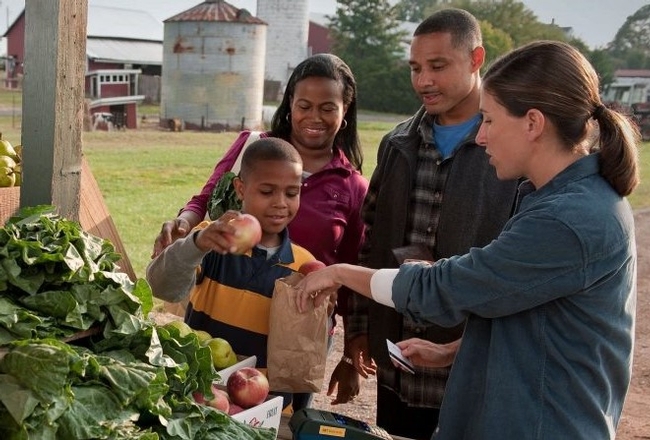
The HHSA, which had been using its text messaging platform to send administrative reminders and alerts, was receptive to using the tool for sending nutrition-focused information. NPI and CCH partnered with ideas42, a firm that applies behavioral science to solutions for social change, to develop a series of five text messages promoting California-grown fruits and vegetables.
The text messages – originally delivered in English and Spanish, with the addition of Arabic beginning in July 2021 – were friendly and conversational in tone.
“In a text, you have very few characters you're communicating with people, so we wanted to make sure we were using cutting-edge behavioral science to construct those messages to have the most impact,” said Wendi Gosliner, NPI senior researcher and policy advisor.
Each text included a link directing recipients to a website developed as part of the project, with information on selecting, storing and preparing California-grown fruits and vegetables; health benefits; tips to reduce food waste; and recipes – including TikTok videos.
Initially running from September 2020 to March 2021, the pilot program was well-received. Nearly 90% of CalFresh participants responding to a survey said they appreciated receiving the texts. “It is very important for us to eat healthy, to teach our children to eat healthy,” wrote one participant. “I love the recipes…they're so delicious and easy to make…I'm very, very grateful for the help because without you guys, I would be struggling more and I just want a better life for my children.”
Gosliner said it was encouraging to see that two-thirds of the approximately 5,000 survey respondents reported eating more California-grown fruits and vegetables after receiving the messages, and 85% expressed a desire to see more texts.
“What we see is that there's definitely a decent-sized population of people participating in CalFresh –now this is just in San Diego County but imagine the entire state – who would benefit from having this kind of information available to them,” Gosliner said. “And there is at least a subset of people who really liked it.”
UC San Diego's Center for Community Health was instrumental in facilitating the partnership between UC ANR and the HHSA. Further, CCH, in partnership with the San Diego County Childhood Obesity Initiative, formed a community council composed of residents representing diverse communities throughout San Diego County. Together, the council facilitated CalFresh participants to take part in focus groups, which provided feedback and guidance on the messaging and design for online resources. Gosliner said the success of the text program has been a direct result of community input and involvement.
“The Center for Community Health-led focus groups were integral to ensuring CalFresh resources were accessible and informative to a wide range of CalFresh participants, and local individuals and families more broadly,” said Blanca Meléndrez, executive director at the UC San Diego Center for Community and Population Health, Altman Clinical Translational Research Institute. “In the process, the text-based campaign also placed a greater focus on the local production of nutritious fruits and vegetables, ensuring access to healthy and nutritious food in all communities, and building new streams of income for the region's farmers and producers.”
This effort also suggests a simple way to reach CalFresh participants and bridge gaps between the Supplemental Nutrition Assistance Program and programming that offers nutrition education and healthy eating resources.
“By combining UCSD and UC ANR knowledge about healthy eating with our outreach capability, we are able to reach thousands of families via text message each month,” said Michael Schmidt, human services operations manager for the HHSA. “With the click of a button, these families are provided with resources to assist them in making healthier lifestyle choices, supporting a region that is building better health, living safely and thriving.”
The effort has been so effective that HHSA has asked for additional messages, beyond the original five months' worth of texts and resources.
“The partnership between UC ANR's Nutrition Policy Institute, UC San Diego's Center for Community Health, the County of San Diego Health and Human Services Agency and San Diego County community residents brought together a great team to develop an innovative, technology-based intervention,” said Shana Wright, San Diego County Childhood Obesity Initiative co-director at CCH. “Each partner provided knowledge, resources and assets that enhanced the project beyond the initial pilot phase, exceeding preliminary expectations.”
Gosliner said the pilot program has been a “great example and wonderful experience” of partnership in action.
“You can sit with your research or program ideas for a long time but if you don't have people who can help you implement them, then they really aren't helpful in any way,” she said. “In this case, it was just a nice combination of an idea…with partners who wanted to work to make something happen.”
UC ANR to work with farmers to apply artificial intelligence technologies in the field
UC Agriculture and Natural Resources will receive $865,000 to help farmers in the Colorado River basin and the Salinas Valley integrate digital tools and artificial intelligence into their growing systems. The funds are part of a $10 million Sustainable Agricultural Systems grant from the USDA's National Institute of Food and Agriculture to improve the sustainability of the nation's food supply.
The intensive agricultural industry of the Colorado River basin – which includes the Palo Verde, Coachella and Imperial valleys in California; the Yuma Valley and other areas, such as Wellton-Mohawk Valley in Arizona – produces vegetables in the winter that are shipped across the country. Salinas Valley farms produce vegetables in the summer for markets throughout the nation.
“Vegetables are an essential part of a healthful diet. With this grant, NIFA is recognizing the role that California, Arizona and Colorado play in growing nutritious food for Americans,” said Khaled Bali, UC Cooperative Extension irrigation specialist. “The sustainability of these production systems into the future, particularly in light of challenges like climate change, increased drought and limited access to surface and groundwater, will require sophisticated technology.”
U.S. agriculture industry professionals are world leaders in the use of technology, including automation, drip irrigation, sensors and drones. “What's new is how you can now integrate technology into making decisions,” said Bali, who is leading the digital agriculture education and outreach aspect of the grant.
Bali said new farming tools work like smart thermostats in homes, which have sensors throughout the house and learn family patterns to make conditions perfectly comfortable throughout the day and night.
On the farm, instead of applying the same amount of water and fertilizer over hundreds of acres, sensors, valves and digital management allow small sectors to get treatments based on soil type, size of plants, pest pressure, salinity and disease management.
“This project will lay the foundation for a long-term shift to highly automated mechanized farm management systems – with full implementation likely decades in the future,” Bali said. “The precise application of inputs in agriculture will save water, reduce the percolation of fertilizer below plant roots, reduce the need for manual labor in the industry, increase yields and decrease expenditures, enhancing the industry's economic viability.”
Field demonstrations, training sessions, videos and handouts will bridge the gap between ongoing farming practices and academic and industry state-of-the-art digital technology. These activities are expected to increase the productivity and competitiveness of major crop growers.
The new project will expand the usage of a smartphone and website app called CropManage, a system developed in 2011 by Michael Cahn, UC Cooperative Extension advisor in Monterey, Santa Cruz and San Benito counties. CropManage allows farmers in the Salinas Valley to input information about their crops and soil, and then automatically receive recommendations about irrigation and fertilization needs that take into account weather conditions reported by the California Irrigation Management Information System (CIMIS), a network of automated weather stations managed by the California Department of Water Resources.
Currently, CropManage makes about 2,000 recommendations to Salinas Valley farmers each month during the growing season. The new funding will allow for the expansion of CropManage to help farmers manage salinity.
“To minimize salt toxicity to the crop, farmers may need to apply water to leach salinity below the root zone. But we don't want to leach nitrates,” Cahn said. “We want to decouple these processes and do the leaching when there are lower nitrogen levels in the system. Determining timing and water amount is something we will build into CropManage.”
The grant will also provide funding for new training and outreach that will enable more farmers to use the CropManage app.
The overarching $10 million grant awarded to UC Riverside is led by professor Elia Scudiero, an expert in soil, plant and water relationships. He and a team of UC Riverside scientists will develop artificial intelligence data needed for smart farming systems with new statistical and algebraic models that find repeated and generalizable patterns.
Another key piece of the effort will be supplying the agriculture industry with the next generation of growers, managers and scientists. Funds from the NIFA grant will establish a Digital Agriculture Fellowship program to recruit more than 50 data, environmental or agricultural science students over the next five years to develop and learn the technology. Internships with key commercial partners are also a feature of the program.
UCCE advisor speaks about vegetable grafting at neighboring university
Zheng Wang, vegetable crops advisor with UC Cooperative Extension in Stanislaus County, visited an ag class at Stanislaus State to discuss a state-of-the-art vegetable production practice that involves grafting, reported Alivah Stoeckl in Stan State News.
Grafting plants onto specially bred rootstocks is a practice that is common in tree crops. Grafting confers resistance to soil-borne diseases and pests, requiring less inputs and leading to sustainable crop productivity. It is now being used in some vegetable and fruit crops, such as tomatoes, eggplant, watermelon, cucumbers and cantaloupe.
“Grafting conveys a lot of merits in terms of disease resistance and yield maintenance. It enriches the production practices by introducing more variety. And by making impossible things become possible,” Wang said.
Vegetable grafting has been used since early 2000s, but to many agriculture students the idea was new, reported Stoeckl.
“We're moving forward and advancing with our food which I think is interesting because we used to be all natural and simple but now it's all scientific,” said senior agriculture major Madeline Morataya.
New video series to spark interest in vegetable production of the future
A 26-episode weekly video series will debut May 13 on YouTube to help train the next generation of vegetable crop workers and increase their use of effective stewardship practices in vegetable production.
Projections for near-future retirements of people working in California's agricultural production, marketing and post-harvest handling sectors indicate severe re-staffing needs in the coming years. Technological advances have reduced manual labor in agriculture, but increased the need for skilled labor to maintain the sustainability of the vegetable industry.
“We already see it happening,” said Jeff Mitchell, UC Cooperative Extension vegetable crops specialist. “Robotic machines are now used for lettuce thinning in Salinas, but these technologies must be serviced by an educated workforce with knowledge in both mechanics and science.”
Mitchell assembled a team of professors from California's public universities with agricultural programs – UC Davis, Chico State, Fresno State and CalPoly San Luis Obispo - to pull together a series of videos designed to spark the interest and begin training future farmers and ag workers in sound agronomic, economic and environmental stewardship skills. The team received financial support from the California Department of Food and Agriculture Specialty Crops Block Grant Program.
“We know that maintaining California's leading role in producing abundant, safe vegetables is critical not only to Americans' health, but also to the state's economy,” Mitchell said.
The video series is offered on the UC Agriculture and Natural Resources (UC ANR) YouTube page on a playlist titled “Training of a New Generation of California Vegetable Producers.” UC ANR is the outreach arm of the University of California which, among other services, provides agricultural research, teaching and advising in all California counties.
Each Monday morning from May 13 through Nov. 4, a new video will premiere in the playlist. The video length ranges from 47 minutes to 7 minutes. The videos will also be made available to high school and college ag professors to use in the classroom.
“We believe that this series of videos on vegetable production will have broad interest beyond the classrooms,” Mitchell said. “The agricultural industry, students in other parts of the United States and the world, and the broader public all have an interest in understanding how the vegetables we eat are produced at the ever-increasing scale at which they are needed.”
The videos depict state-of-the-art technologies and techniques that are in use in many production regions of California today, vegetable farming systems used in other parts of the world, and increasingly popular cottage farming systems that are popping up in urban areas for easy access to healthful foods.
To receive a notification of each video premiere, follow the UC ANR Twitter feed at http://twitter.com/UCANR or set a reminder by visiting the playlist on YouTube.
